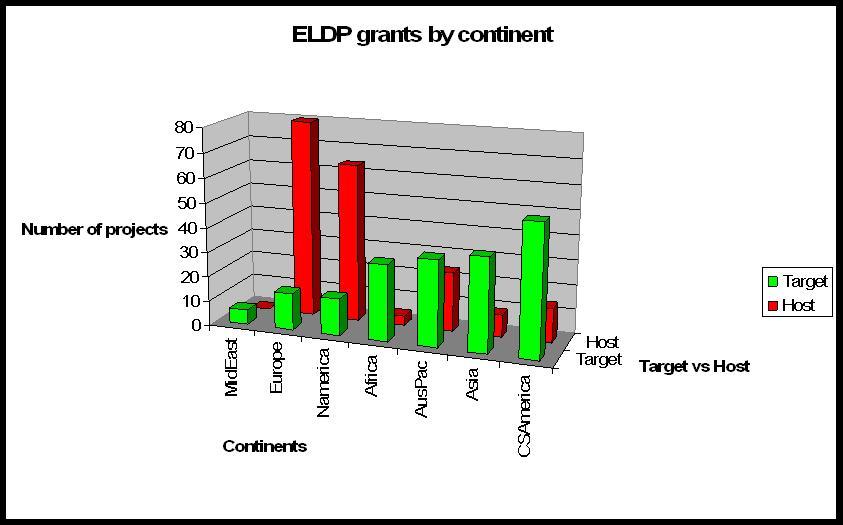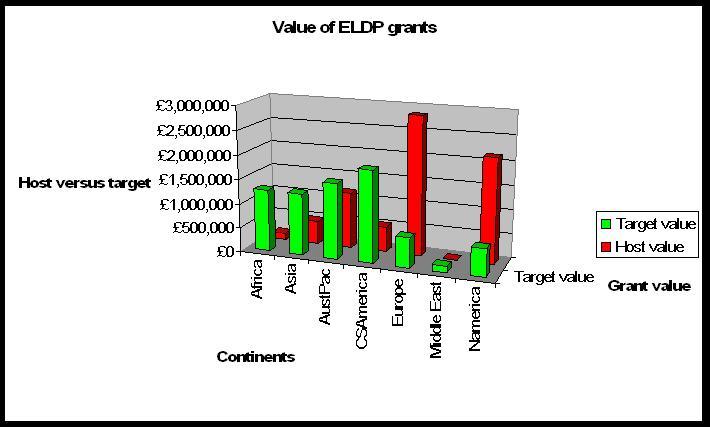About 18 months ago I wrote a blog post about potential sources of funding for endangered languages research. I identified three main types of funders: governmental grant bodies, non-governmental grant bodies, and endangered languages grant bodies. The Endangered Languages Documentation Programme (ELDP), which is a sister to the Academic Programme (ELAP) and the Endangered Languages Archive (ELAR) at SOAS, is one of the largest in the last category, distributing around GBP 1million per year in competitive grants.
As part of my current interest in meta-documentation, that is the documentation of language documentation (see this recent conference abstract, and a differently focussed workshop abstract [.pdf]), I have been looking at how granting agencies, and ELDP in particular, spend their funds. Where is funded research being carried out and where is the money being allocated to? Are there any changes over time that can be observed?
I chose to look at ELDP because it has global coverage in terms of the research areas it is interested in and in terms of which researchers it is prepared to fund. It also publishes information about the grantees and the size of the grants awarded, so data collection is easy. Volkswagen Foundation, in contrast, requires a German component in their DoBeS projects, while NSF-NEH Documenting Endangered Languages (DEL) grants are restricted to US Institutions.
I wish to make it clear that although ELDP is administered by SOAS staff, its grant decision making processes are entirely independent of SOAS and are carried out by an International Panel chaired by Andrew Spencer of the University of Essex. The opinions I am expressing here are also independent of ELDP itself.
An examination of grants awarded by ELDP from 2002 to 2009 (the figures for the 2010 grant round are not yet available) reveals some interesting trends. In the 8 year period ELDP awarded 193 grants worth GBP 7.3million (at an average of GBP 37,000 per grant, though they range from GBP 1,436 to GBP 128,188, with 77 (40%) valued at GBP 10,000 or less). If we look at geographical distributions, in terms of number of grants awarded, most went for work on languages located in Central and South America (53), followed by Asia (38), Australia-Pacific (35), Africa (31), North America (15) and Europe (15). In contrast, the location of host institutions to which the grants were paid reveals an almost opposite distribution: Europe (80), North America (64), Australia-Pacific (24), Central and South America (14) with Asia (9) and Africa (4) well behind. The following bar chart shows this (red bars show where the host institutions are located while green bars show where the languages being documented are located).

If we look at the geographical distribution of the value of grants awarded, the figures are even more skewed. European host institutions received GBP 2.85million (40% of the total), and North American institutions GBP 2.15million (30%). The remaining 30% was very unevenly split between Australia-Pacific at GBP 1.16million (16%), Asia GBP 483,000 (7%) and Africa with GBP 138,000 (2%). In other words, 16% of ELDP grants have been allocated for work on African languages but only 2% of the funds awarded went to African institutions. For Asia the situation is slightly better: 20% of ELDP grants were for Asian languages and 7% of the funds have gone to Asian institutions. This bar chart shows the value by continent for host institutions (red bars) and regions where the languages are spoken (green bars):

I have not been able to analyse the figures over time fully yet but my impression is that African, Asian and Latin American based scholars are showing more success in recent funding application rounds than they did back in 2002-2003. Whether these trends might continue into the future will be interesting to watch.
 Follow
Follow
This analysis seems to be addressing an implied question about community or economic development: how much ELDP money is flowing to developed regions v. developing regions. But essentially the analysis here is only telling us where the strongest universities are (Europe, NAm) and where the most at-risk languages are (not Europe, MidEast, NAm – well kind of NAm, but there may will be half-decent government funding alleviating the need for ELDP funds). The results are interesting, but all together not terribly surprising.
What would be more interesting in my opinion is to capture a picture of where the money flowed within grants. e.g. how much of the grant was used in the target country v. host country. how much went directly to endangered language speakers/community members. how much went towards travel/accommodation/wage costs for researchers etc. This would give a better picture of the spread of economic or community development. But again, it would still be flawed. Would be great to also find out what follow-up projects came after the ELDP grants. What training was carried out during the grant and continued on with beyond the project period. What language-oriented employment local people continued with beyond the grant. But these things are a lot harder to measure and gauge. And it would say nothing about the quality of training or post-ELDP projects either.
(Note though, I’d be happy to submit this kind of info as part of my ELDP reporting requirements).
Thanks, Wamut, for your detailed comments. Firstly, I had not intended “an implied question about community or economic development” but rather to highlight where the research is being done and where the grant money is being allocated to. I leave the implications of this up to the reader — maybe it is “only telling us where the strongest universities are” (though ELDP does also fund research carried out at non-university organisations) but maybe it is also reproducing other (post-colonial) disparities. As for the other “more interesting” issues you mention, especially the tangible and non-tangible outcomes of the funded research, I agree that finding out about them might be interesting and useful, but I don’t have access to this kind of detailed breakdown of grant expenditures, or to research biographies. Perhaps the new Director and Administrator of ELDP who were appointed this year will initiate an evaluation of the outcomes and impacts of the more than GBP 7.3million allocated by the International Panel so far.